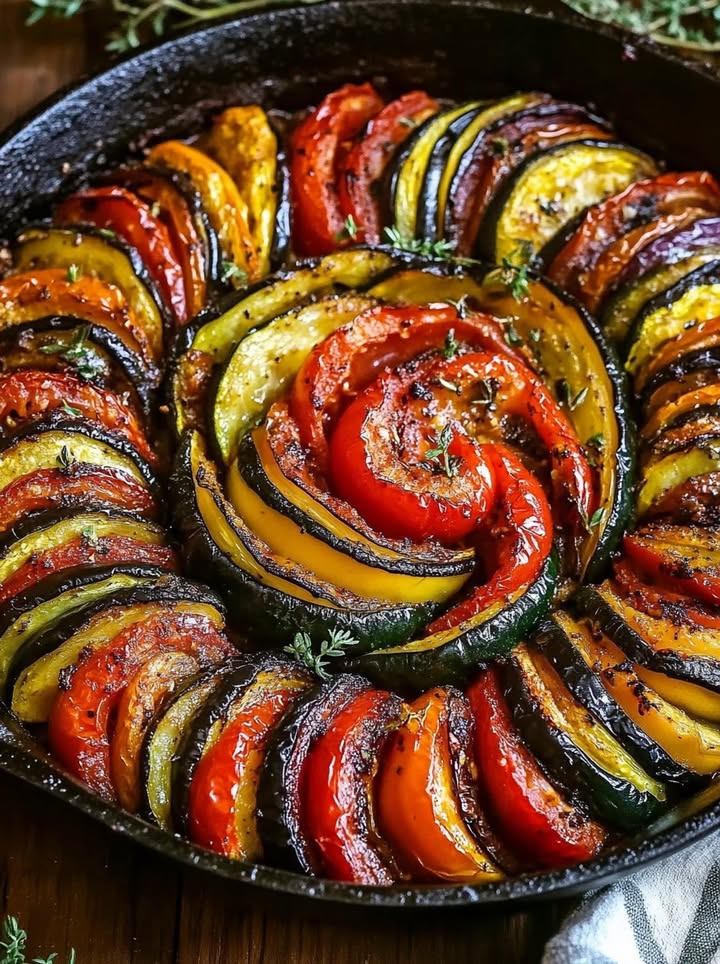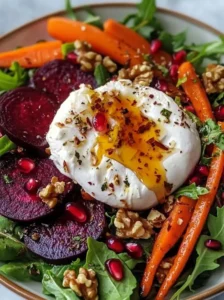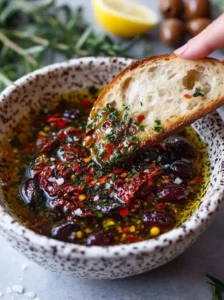Classic Baked Ratatouille with Tomatoes and Zucchini: A Provençal Vegetable Masterpiece
This classic baked ratatouille with tomatoes and zucchini brings the flavors of Provence straight to your kitchen. Imagine tender vegetables layered in perfect harmony, each bite bursting with Mediterranean sunshine. The slow baking process melds the flavors while maintaining beautiful texture contrasts between the creamy eggplant and firm zucchini.
Traditional ratatouille recipes vary across southern France, but this baked version offers visual appeal and concentrated flavors. As the vegetables roast, their natural sugars caramelize while fresh herbs infuse every component. Whether serving as a vegetarian main or elegant side dish, this ratatouille delivers both rustic charm and refined taste.
Quick Recipe Highlights
- Flavor Profile: Earthy eggplant balances bright tomatoes and sweet zucchini, while garlic and herbs add depth.
- Texture: Silky roasted vegetables retain slight firmness with occasional caramelized edges.
- Aroma: Fragrant basil and thyme mingle with roasted garlic and olive oil during baking.
- Visual Appeal: Colorful vegetable spirals create an impressive presentation worthy of special occasions.
- Skill Level Needed: Basic knife skills and simple assembly make this accessible to novice cooks.
- Special Equipment: A mandoline slicer helps achieve uniform vegetable thickness but isn’t essential.
Recipe Overview
- Difficulty Level: This ratatouille recipe requires minimal techniques but benefits from careful vegetable arrangement.
- Category: Works equally well as a vegetarian main course or substantial vegetable side dish.
- Cuisine: Hails from Provence but has become a French culinary staple with global adaptations.
- Cost: Budget-friendly using seasonal summer vegetables and pantry staples.
- Season: Perfect for late summer when tomatoes and zucchini reach peak flavor.
- Occasion: Impressive enough for dinner parties yet simple enough for weeknight meals.
Why You’ll Love This Recipe
The classic baked ratatouille with tomatoes and zucchini satisfies on multiple levels. First, the flavor combination creates perfect harmony between sweet, savory, and herbal notes. Second, the preparation method allows flexibility while guaranteeing delicious results every time. Third, the dish accommodates various dietary preferences without compromising taste.
Nutritionally, this vegetable-packed dish delivers vitamins, fiber, and antioxidants. The olive oil provides healthy fats while the variety of vegetables ensures diverse micronutrients. Unlike heavy casseroles, ratatouille feels nourishing yet light enough for warm weather dining.
Entertaining becomes effortless with this make-ahead dish that actually improves in flavor. The vibrant colors and artful arrangement make it a showstopper on any table. Guests appreciate both the visual appeal and the fact that it suits vegetarian, vegan, and gluten-free diets.
Economical home cooks appreciate how ratatouille transforms affordable seasonal produce into something special. The recipe adapts easily to whatever vegetables look best at the market. Leftovers taste even better the next day, making it practical for meal prep.
Ultimately, this classic baked ratatouille with tomatoes and zucchini offers the perfect balance of simplicity and sophistication. The recipe teaches fundamental cooking techniques while delivering restaurant-quality results. Whether you’re cooking for family or company, it consistently earns compliments.
Historical Background and Cultural Significance
Ratatouille originated in Provence as a peasant dish designed to use abundant summer vegetables. Farmers would combine whatever produce they had available, slow-cooking it to develop deep flavors. The name comes from the French “ratouiller” meaning “to stir up,” reflecting its humble mixed-vegetable beginnings.
During the 18th century, ratatouille gained popularity beyond rural areas as Provençal cuisine became fashionable. Cooks refined the preparation methods while maintaining the essential vegetable combinations. The baked version emerged later as home ovens became more common in French households.
Today, ratatouille represents quintessential French country cooking at its best. The dish appears in bistros across France and has inspired countless international variations. Its appearance in popular culture, especially animated films, introduced ratatouille to global audiences.
Regional differences abound in preparation methods. Some versions feature all vegetables cooked together, while others layer components like this baked ratatouille with tomatoes and zucchini. The common thread remains fresh, seasonal produce prepared with respect for each ingredient’s qualities.
Ingredient Deep Dive
Eggplant forms the foundation of classic ratatouille, providing meaty texture and absorbent qualities. Look for firm, glossy specimens with smooth skin and fresh green stems. Smaller eggplants typically have fewer seeds and milder flavor. Salting before use draws out bitterness and improves texture.
Zucchini contributes sweetness and structure to the vegetable medley. Choose medium-sized zucchini with bright green skin and firm flesh. Oversized zucchini can become watery and seedy. The vegetable’s mild flavor makes it perfect for absorbing herb and garlic notes during baking.
Tomatoes provide acidity and moisture to balance the other components. Plum tomatoes work particularly well for their meaty texture and concentrated flavor. In winter, canned San Marzano tomatoes make an acceptable substitute. The tomato sauce base ties all the vegetable flavors together.
Common Mistakes to Avoid
- Skipping the salting step for eggplant results in bitter flavors and soggy texture.
- Cutting vegetables unevenly leads to inconsistent cooking times and textures.
- Overcrowding the baking dish prevents proper caramelization and steaming occurs instead.
- Using out-of-season tomatoes creates a watery sauce lacking depth of flavor.
- Overbaking makes vegetables mushy rather than tender with slight firmness.
- Skimping on olive oil sacrifices flavor and can cause sticking.
- Adding fresh herbs too early in cooking diminishes their bright flavor impact.
- Neglecting to let the dish rest before serving prevents flavors from fully melding.
Essential Techniques
Proper vegetable preparation ensures even cooking and beautiful presentation. First, slice all components to consistent thickness, about 1/8-inch for optimal texture. A mandoline achieves perfect uniformity, though careful knife work suffices. Next, salt the eggplant and let it drain to remove excess moisture.
Layering requires attention to both aesthetics and functionality. Alternate vegetables in concentric circles or straight rows depending on your baking dish. The tomato sauce base should just peek between the slices. This arrangement allows steam circulation while creating visual appeal.
Baking temperature proves crucial for perfect ratatouille. Moderate heat around 375°F caramelizes the vegetables without burning. Covering for the first half of cooking ensures tenderness, then uncovering promotes slight browning. The finished dish should show golden edges but retain vibrant colors.
Pro Tips for Perfect Classic Baked Ratatouille
- Use a pastry brush to coat each vegetable slice with olive oil before arranging.
- Reserve some fresh herbs to sprinkle over the finished dish for maximum aroma.
- Let the baked ratatouille rest 15 minutes before serving to allow flavors to settle.
- Consider adding a splash of balsamic vinegar to the tomato sauce for complexity.
- Layer some fresh basil leaves between vegetable slices for hidden bursts of flavor.
- Use the leftover ratatouille liquid to make a flavorful soup base the next day.
Variations and Adaptations
Seasonal adaptations keep ratatouille interesting year-round. In winter, roasted red peppers and butternut squash make excellent additions. Spring versions might include artichokes and young onions. The basic technique works with nearly any combination of seasonal vegetables.
For protein additions, white beans or chickpeas blend seamlessly into the vegetable mix. Some cooks add anchovies or olives for briny depth. Vegetarians might appreciate crumbled feta or goat cheese sprinkled over the top before serving.
Presentation variations abound for different occasions. Individual ramekins create elegant single servings. A free-form tart version with puff pastry makes impressive party fare. For casual meals, simply chop all vegetables and bake them mixed together.
Serving and Presentation Guide
Traditional Provençal presentation keeps the vegetable arrangement intact when serving. Use a wide spatula to lift portions while maintaining the spiral pattern. Garnish with fresh herb sprigs and a drizzle of high-quality olive oil for visual appeal.
Accompaniments should complement without overwhelming the delicate vegetable flavors. Crusty bread helps soak up the flavorful juices. A simple green salad with lemon vinaigrette provides refreshing contrast. For heartier meals, serve alongside grilled fish or roasted chicken.
Temperature considerations affect both flavor and texture. Ratatouille tastes wonderful warm or at room temperature, making it ideal for buffets. If serving hot, reheat gently to prevent the vegetables from breaking down. Chilled leftovers make excellent sandwich fillings or omelet ingredients.
Wine and Beverage Pairing
Classic Provençal rosé makes the perfect pairing with its bright acidity and berry notes. Light-bodied reds like Grenache or Pinot Noir also complement without overpowering. For white wine lovers, a crisp Vermentino or unoaked Chardonnay works beautifully.
Non-alcoholic options include sparkling water with lemon or herbal iced tea. The effervescence cleanses the palate between bites. For something special, try a virgin basil lemonade that echoes the dish’s herbal notes.
Coffee pairings should lean toward medium roasts with bright acidity. The caramel notes in the coffee enhance the roasted vegetable flavors without clashing. Lightly brewed teas like jasmine or chamomile make soothing post-meal accompaniments.
Storage and Shelf Life
Properly stored ratatouille maintains quality for several days. Cool completely before transferring to airtight containers, leaving minimal headspace. Refrigerated portions keep well for up to 5 days, with flavors improving over the first 48 hours.
Freezing works surprisingly well for this dish, though texture softens slightly. Portion into freezer bags, removing excess air, and freeze for up to 3 months. Thaw overnight in the refrigerator before reheating gently on the stovetop.
Reheating requires gentle heat to preserve textures. A covered skillet over low heat works better than microwave reheating. Add a splash of water or broth if the mixture seems dry. For best results, bring to serving temperature slowly.
Make Ahead Strategies
Advance preparation streamlines the cooking process significantly. The tomato sauce base can be made up to 3 days ahead and refrigerated. Vegetables can be sliced and stored in separate containers overnight, though eggplant benefits from last-minute salting.
For entertaining, assemble the entire dish early in the day and refrigerate until baking time. Add 10-15 minutes to the cooking time if starting from cold. The resting period after baking allows flavors to develop fully.
Partial baking works well for meal prep. Bake the ratatouille about 80% done, cool, and refrigerate. Finish baking just before serving to refresh the textures. This method preserves the fresh appearance while minimizing last-minute work.
Scaling Instructions
Doubling the recipe works beautifully for large gatherings. Use two baking dishes rather than one oversized one to ensure even cooking. Increase baking time by about 10-15 minutes, checking for doneness at the original time.
For smaller portions, halve all ingredients and use a 9-inch pie plate. Reduce baking time by about 10 minutes, checking frequently. The smaller volume cooks faster and may require less covered time.
When scaling up, maintain the vegetable-to-sauce ratio carefully. Too much sauce makes the dish soupy, while too little causes dryness. The layered vegetables should sit snugly in the sauce without floating.
Nutritional Deep Dive
This classic baked ratatouille with tomatoes and zucchini offers impressive nutritional benefits. The variety of vegetables provides diverse phytonutrients and antioxidants. Eggplant contains nasunin, a potent antioxidant that protects cell membranes.
Zucchini contributes vitamin C and manganese while being low in calories. Tomatoes provide lycopene, especially bioavailable when cooked. The olive oil enhances nutrient absorption of fat-soluble vitamins present in the vegetables.
Each serving contains about 150-200 calories, making it a weight-conscious choice. The high fiber content promotes satiety while supporting digestive health. The dish naturally contains no cholesterol and minimal saturated fat.
Dietary Adaptations
Vegan versions require no modifications as the recipe contains no animal products. For added richness, some cooks swirl in plant-based cream before serving. Nutritional yeast can provide umami depth if desired.
Low-carb adaptations might reduce higher-carb vegetables like tomatoes and increase zucchini. Adding more olive oil and some pine nuts boosts healthy fats while keeping carbs in check. The dish naturally suits Mediterranean diet guidelines.
For nightshade-free versions, substitute carrots and celery for the tomatoes and eggplant. Use yellow squash instead of zucchini if needed. The preparation method remains the same, though flavors will differ from traditional ratatouille.
Troubleshooting Guide
Watery results typically come from under-salted eggplant or overly juicy tomatoes. Next time, salt the eggplant more thoroughly and drain well. For immediate fixes, strain excess liquid and reduce it separately to concentrate flavors.
If vegetables remain too firm, extend the covered baking time in 5-minute increments. Check frequently to prevent overcooking. Underseasoning often occurs when salting only at the end. Season each component layer for balanced flavor throughout.
Burnt edges indicate oven hotspots or insufficient covering. Rotate the dish halfway through baking and ensure proper foil coverage. If some slices darken too much, simply remove those before serving.
Frequently Asked Questions
Can I use different vegetables in ratatouille? Absolutely. While traditional versions use eggplant, zucchini, and tomatoes, feel free to incorporate bell peppers, mushrooms, or other seasonal produce.
Do I need to peel the eggplant? Not necessary with modern varieties. The skin adds color and nutrients, though some prefer peeled eggplant for ultra-tender texture.
Can I make ratatouille in a slow cooker? Yes, though textures will differ. Layer ingredients as directed and cook on low for 4-5 hours. Remove the lid for the last 30 minutes to reduce liquid.
Why does my ratatouille taste bland? Underseasoning is the likely culprit. Be generous with salt during preparation and consider adding a splash of vinegar or lemon juice at the end.
How do I know when ratatouille is done? Vegetables should be tender but not mushy, with slightly caramelized edges. A knife should slide in easily with slight resistance.
Can I freeze ratatouille? Yes, though texture softens slightly upon thawing. Freeze in portion-sized containers for up to 3 months. Thaw overnight in refrigerator before reheating.
What’s the difference between ratatouille and caponata? Caponata is a Sicilian dish with similar vegetables but includes capers, olives, and a sweet-sour flavor profile from vinegar and sugar.
Can I make ratatouille without tomatoes? While unconventional, you could substitute roasted red pepper puree. The flavor profile will differ but can still be delicious.
How do I prevent soggy ratatouille? Proper salting of eggplant, thorough draining, and not overcrowding the baking dish all help maintain ideal texture.
What herbs work best in ratatouille? Thyme, basil, and oregano are classic choices. Rosemary can overpower, while tarragon adds interesting licorice notes.
Additional Resources
For those inspired by this classic baked ratatouille with tomatoes and zucchini, consider exploring other Provençal dishes. Vegetable tians use similar layering techniques with different ingredient combinations. The French tradition of vegetable cookery offers endless variations on seasonal produce preparations.
Technique-focused cookbooks provide deeper understanding of fundamental skills used in ratatouille. Knife work, vegetable preparation, and sauce making all contribute to successful execution. Understanding these basics elevates all your cooking, not just French dishes.
Seasonal eating guides help identify the best times for various vegetables. Peak-season produce always yields superior flavor and texture in simple preparations like ratatouille. Many farmers’ markets now offer heirloom varieties that add interesting flavor dimensions.
PrintClassic Baked Ratatouille with Tomatoes and Zucchini
Description
A vibrant and hearty vegetable dish featuring layers of tomatoes, zucchini, and eggplant, baked to perfection with aromatic herbs.
Ingredients
For the Crust:
- 2 medium zucchinis, sliced
- 1 large eggplant, sliced
- 4 medium tomatoes, sliced
- 1 onion, thinly sliced
- 3 cloves garlic, minced
- 1/4 cup olive oil
- 1 tsp dried thyme
- 1 tsp dried rosemary
- Salt and pepper to taste
- 1/4 cup fresh basil, chopped
Instructions
1. Prepare the Crust:
- Preheat oven to 375°F (190°C). Lightly grease a baking dish.
- Arrange the sliced zucchini, eggplant, tomatoes, and onion in alternating layers in the baking dish.
- In a small bowl, mix the minced garlic, olive oil, thyme, rosemary, salt, and pepper. Drizzle over the layered vegetables.
- Cover the dish with foil and bake for 25 minutes. Remove the foil and bake for another 5 minutes until the vegetables are tender.
- Garnish with fresh basil before serving.
Notes
You can customize the seasonings to taste.





